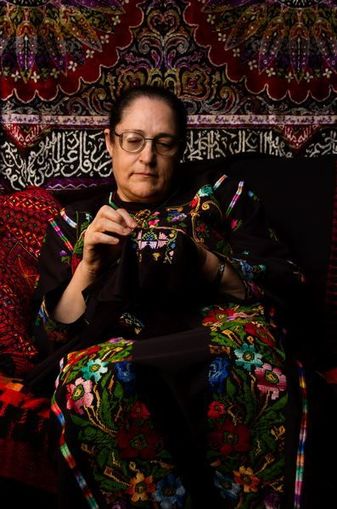
Ellen Spitaleri
Portland Tribune
The key to understanding Wafa Ghnaim’s presentations at the Ledding Cultural Forum on Sept. 17, 18, and 19 is in the title of her book: “Tatreez & Tea: Embroidery & Storytelling in the Palestinian Diaspora.”
Tatreez is a transliterated Arabic word meaning embroidery, needlework and the ornamentation of fabric.
“The premise of the book is to preserve oral history, share the stories and meanings associated with the designs, and to express the significance of Palestinian embroidery,” Ghnaim said.
She added that the Palestinian diaspora refers to the “destruction and dispersal of the Palestinian community, [whose members were] splintered all over the globe [when] they were expelled from their home in 1948 by Israeli troops.”
Ghnaim and her mother, Milwaukie resident Feryal Abbasi-Ghnaim, set up their three presentations to tell the oral history associated with each traditional design.
They will not be teaching any actual embroidery techniques, but instead “will share the intricate, handmade, embroidery designs with the audience, so they can see firsthand the colorful, cross-stitched designs, and we can decode what each segment means,” Ghnaim said.
All three sessions will be held at the Ledding Library, 10660 S.E. 21st Ave., in Milwaukie.
‘Sacred art’
In 1990, Ghnaim and her family moved to Milwaukie, where she lived until 2012. She graduated from Milwaukie High School in 2001, and her parents still own her childhood home.
Ghnaim now lives in Brooklyn, New York, with her husband and works at a Manhattan translation-technology firm full-time. She also is pregnant with her first child.
Ghnaim learned embroidery from her mother, who has been teaching and practicing the craft her entire life. It was her mother who first dreamed of writing a book about the significance of Palestinian embroidery.
“In Palestinian tradition, mothers pass on this sacred art to their daughters. In the same spirit, my mother taught me and my sisters this art at a young age. We grew up assisting her in demonstrations, lectures and exhibitions,” Ghnaim said.
In 1995, the Oregon Historical Society granted Ghnaim and her sisters an apprenticeship to create a large embroidery project with their mother, and “in those early sessions 20 years ago, my mother passed on the idea of writing [this] book to me,” she said.
During the diaspora, Ghnaim’s family fled to Syria in 1948; some lived in the Yarmouk refugee camp and other Palestinian communities.
Ghnaim said she spent most of her 20s retracing her mother’s steps in the refugee camp and all over the Syrian city of Damascus, learning about how her mother’s embroidery “impacted others and how much meaning her work carried for Palestinians in Syria.”
Then the Syrian war started in 2011, and she began to realize that it may be a long time before she sees family members who are still in that war-torn country.
“After years of struggling with depression and trying to cope with my hopeless feelings about Syria, I decided that the only way to honor my mother’s life and my family in Damascus is to write this book; to share their memories of embroidery, and the craft culture that still exists today,” Ghnaim said.
Nature, children’s designs
In their first Cultural Forum session from 1 to 2 p.m. Sept. 17, Ghnaim and her mother will discuss the traditional wheat harvest embroidery design and the many themes of nature, flora and fauna in Palestinian embroidery.
Before the diaspora, “there was a significant native Palestinian Arab population who were farmers who had spent generations cultivating and harvesting their land,” she said.
“The sudden loss of land was devastating, and when they were expelled to another country without right to landownership, they were essentially stripped [of] their ancestral identity and life’s purpose,” Ghnaim said.
“This is the beauty behind Palestinian embroidery. We not only preserve the needlework traditions that capture the pride of land and harvest season, we are also reminded, through the designs, of so many traditions we have lost,” she said.
The presentation on children’s designs, set for 1 to 2 p.m. Sept. 18, “will be a storytelling session about why it was significant to embroider children’s clothing in old Palestine, and how we can keep the tradition alive in the Palestinian diaspora,” Ghnaim said.
“My mother created embroidered dresses for my sisters and me when we were young. I feature four of these dresses in the book, as well as answer why Palestinian women created these dresses for their daughters,” she said.
Gardens dress
The gardens design session from 7 to 9 p.m. Sept. 19 is likely to be the most personal one for Ghnaim.
The 1995-96 apprenticeship that Ghnaim and her sisters shared with their mother “was a pivotal moment in our lives because, for the first time, we could embroider with her on a dress we’d been watching her create our whole lives. It is called the gardens dress, which we will be sharing in the event at the Ledding Library,” she said.
“The gardens dress was like our fourth sister, we grew up with her, worked on her, and watched her blossom into the colorful garden she was always meant to become. It was a life-changing experience to help my mother with this dress at such a young age,” Ghnaim said.
She added, “The gardens dress is the centerpiece of the book. The dress itself traces back my entire childhood, my growth as an embroiderer and as a Palestinian-American woman.”
Giving back
“Tatreez & Tea: Embroidery and Storytelling in the Palestinian Diaspora” was made possible with funding from the Regional Arts & Culture Council, the Clackamas County Cultural Coalition, and the Brooklyn Arts Council, so Ghnaim said it was only fitting to give back to the Clackamas community through the Cultural Forum event.
“My mother and father have spent most of their adult life in Milwaukie, raising us as Palestinians and as Americans. Embroidery and storytelling traditions in my family have helped preserve Palestinian traditions, when we felt so much pressure to assimilate or hide our ethnicity,” she said.
Growing up in Milwaukie, Ghnaim said she was bullied “for being different, having an ethnic name, and not looking like everyone else.”
Then as a teenager, she rebelled and distanced herself from Palestinian traditions, especially embroidery.
But while writing the book, she realized that it “was never too late to come back to my culture and my embroidery. It was nothing to be ashamed of.”
She added, “It doesn’t matter how long you stray, or how distant you feel from Palestine or from your native culture — home is home. Your identity is always yours.”
While her ancestral roots are in Palestine, Ghnaim chose to launch her book at the Ledding Library event to honor her family’s history in Milwaukie.
Ghnaim added: “For Palestinians, it is difficult to feel that you are at home anywhere you go. You feel unsettled in spirit, searching for your way back to Palestine. But I’ve grown to realize that Milwaukie is one of my homes in this world, and it is never too late to pick up the needle and thread, make a cup of tea and remember where I came from.”
Book launch
What: Wafa Ghnaim discusses her book, “Tatreez & Tea: Embroidery & Storytelling in the Palestinian Diaspora.” Her mother, Feryal Abbasi-Ghnaim, will be co-presenter.
When: Come to one or all three sessions. Session 1: The wheat harvest design, 1-2 p.m. Sept. 17; Session 2: Children’s designs, 1-2 p.m. Sept. 18; and Session 3: The gardens design, 7-9 p.m. Sept. 19.
Where: Ledding Library, 10660 S.E. 21st Ave., Milwaukie
More: In her book, Ghnaim features 13 traditional Palestinian embroidery designs that bore the most significance to her family over the past 100 years. Included are patterns, meanings, design histories and family stories that contextualize the significance of each piece. Online: tatreezandtea.com; preorder the book at amazon.com/dp/B01L7KT7GO
Source: portlandtribune.com




